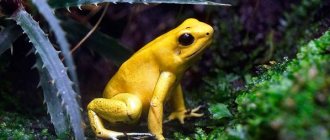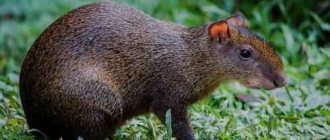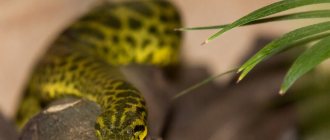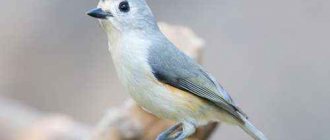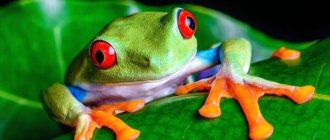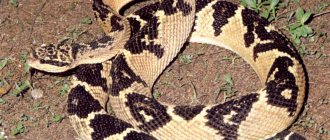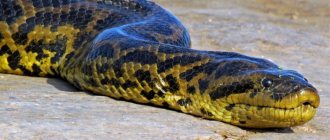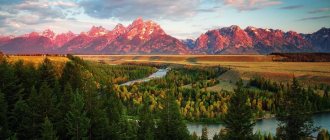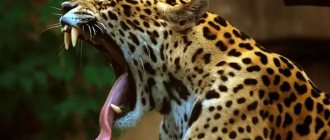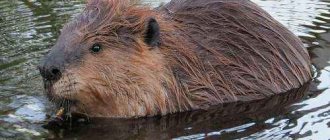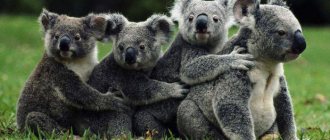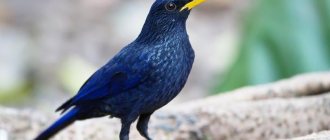South America is part of the American continent, consisting of two continents. Here you can endlessly be surprised and rejoice at the bright nature, in which many bright colors are mixed. The nature of the mainland served as the backdrop for the movie “Avatar,” and this is no coincidence: the landscapes here are truly fantastic. Animals living in South America are equally unusual and colorful.
Geographical position
The continent is located in the equatorial, subequatorial, tropical, subtropical and temperate climatic zones. The continent is entirely located in the Western Hemisphere, most of it located below the equator. The continent is washed by the waters of the Atlantic and Pacific Oceans.
Extreme points of the continent:
- northern - Cape Gallinas.
- southern - Cape Forward.
- western - Cape Parinhas.
- eastern - Cape Cabo Branco.
Epiphytes
South American tropical forests are full of epiphytes that bloom brightly and colorfully.
These plants live on others, but do not parasitize them, but simply use them as support. These are representatives of the families of aroyniaceae, ferns and others, as well as orchids and gloriosa flowers, which are unique in their sophistication and beauty. The very high density of the equatorial forest stimulated the development of many plants in the competition for sunlight. This is how many plants evolved, becoming epiphytes and finding a way to climb to a higher layer of the tropical forest. Unfortunately, it is impossible to list all the representatives inhabiting the flora of South America; the list would be too long.
nature
Population
The total population is about 422 million people. The ethnic composition is very diverse: about 250 different races live here. Such a wide variety is due primarily to the history of the continent.
The inhabitants of the mainland can be divided into representatives of three races:
- equatorial (indigenous population - Indians);
- Caucasoid (descendants of European conquerors);
- Negroid (descendants of slaves brought from Africa).
In addition, representatives of mixed races live here:
- mulattoes (a mixture of Europeans and Africans);
- mestizos (a mixture of Europeans and Indians);
- sambo (a mixture of blacks and Indians).
Rapid mixing of peoples began to occur after the capture of the mainland by the Spaniards and Portuguese. Before that, five centuries ago, only indigenous Indian tribes lived here. The import of slaves from Africa was of great importance for the ethnic and cultural development of the continent: they brought their own special flavor.
Thule tree
Not far from the Mexican city of Oaxaca grows an incredible Tule tree.
The diameter of its trunk is about 11.5 meters.
Scientists believe that the age of this tree is approaching 2000 years. There was an opinion that in fact this is not one, but three trees, so intricately fused with each other, but research has refuted these rumors: the Tule tree is one, and it is still alive.
Relief
The continent's topography is extremely diverse. The continent can be conditionally divided into two parts: the lowlands of its Western part and the mountains of the East.
In the west is the largest Guiana Plateau - its length is 1,600 kilometers. Here is the world's highest Angel Falls, whose height is about 950 meters.
There are also dense tropical forests and many gorges here.
Here, in the west of the continent, there are two more large lowlands: the Amazonian (formed due to its location near the Amazon) and the Guiana Plateau.
In the east of the continent is the longest mountain range on the planet - the Andes. Its length is about 10 thousand kilometers, and its highest point is Aconcagua, 6969 meters. Due to volcanic activity, mountain building continues here to the present day. The last significant volcanic eruption was recorded in Chile in 2010.
Features of the nature of South America
The mainland is distinguished by a large amount of green vegetation and the content of various minerals. Oil, gas, hard and brown coal, and various types of ore (precious stones, iron, copper, aluminum) are mined here. The geological structure of the continent affects the occurrence of minerals. South America is home to the longest river in the world, the Amazon, the highest Angel Falls, with a fall height of more than 1 km, and the longest mountains - the Andes.
The area of South America is well supplied with water resources, thanks to the flowing surface deep rivers, as well as groundwater. The distance from other continents has helped preserve the incredible diversity of a huge number of representatives of the animal and plant world.
Natural areas
Despite the relatively small area of the mainland, several different natural zones were able to accommodate here.
Equatorial rainforests (selvas)
Located in the Amazonian lowlands. This natural area is characterized by moist ferrallitic soil, and therefore the plant life here is very diverse. It is represented by orchids, various ficus trees, melon trees, chocolate tree, various vines and ferns.
Savannahs (Llanos)
Savannas are located on the Guiana Plateau, the Orinoco Lowland, and the Brazilian Highlands. This natural area is characterized by a very warm and dry climate (with the exception of the south of the Brazilian Highlands, where the soil is very fertile and humid). Savannah is rich in animals: here you can find an ostrich, an anteater, a deer, and a baker pig.
Deserts and semi-deserts
The long chain of the Andes blocks the path to the deserts for humid air masses, so there is a very dry climate and sparse vegetation. Feather grass, various types of cacti, and low-growing grasses predominate. The soil here is clayey, infertile, and rich in salt.
Temperate forests (hemigilea)
This natural area is located at the foot of the Andes Mountains. Here, podzolic brown soils predominate, on which bamboo, magnolias, and cypresses grow in abundance. The fauna of the forests is represented mainly by bears and chinchillas.
Lianas
Lianas deserve special attention. The flora of South America would be significantly depleted if these interesting plants were not present. The Gila of South America is distinguished by its variety of vines.
These climbing plants can be perennial, annual, herbaceous, woody or deciduous. But there is one quality that they do not possess - they cannot be erect and independently maintain the vertical position usual for other plants. They always need a support to hold on to using various means provided for them by nature. Adhering to the support, clinging to it, the vine grows and develops. It is designed this way, and anything can serve as a support for it - a tree, a fence. Not being a separate family, vines are dispersed among many other genera, found in various families, in particular, mulberry, saxifrage, euphorbia, amaryllis and many others.
The most famous liana is syngonium. There are almost twenty of its species in the wild, some of which are cultivated for domestic growth. True, it is very difficult to get it to bloom at home. And in the conditions of the equatorial forest, it not only blooms with small yellow flowers, but also forms completely edible fruits. The flora of South America is rich and diverse. In addition to the listed representatives, there is also a huge segment of the most unusual plants.
Climate by season
South America is located almost entirely in the Southern Hemisphere and its seasons are completely opposite to those of the Northern Hemisphere.
The summer period here runs from October to March. During this period, the air temperature can fluctuate from 15 to 35 degrees above zero. During the daytime it is hot and dry here; at night, as a rule, there is a significant drop in temperature; in the mountains the temperature can drop below zero. In summer, the most precipitation falls here.
The weather in winter may differ in different climate zones, although in general the annual amplitude of temperature fluctuations on the mainland is not very large. In the mountains in winter the temperature can be below zero and snow often falls. The average temperature on the mainland, as a rule, is 16-24 degrees above zero.
The autumn and spring seasons are very weakly expressed; weather conditions during these periods may also differ depending on the climate zone, however, all zones are characterized by a humid, warm climate, with an average temperature of about 10-25 degrees Celsius.
Precipitation
South America is the wettest continent on the planet. This is due to its location: most of it is located in the equatorial zone. In the Amazon River Valley, about 3,000 mm of precipitation falls annually in the form of rain.
To the north of the equatorial belt, not far from the ocean, there is a subequatorial zone, mostly occupied by variable equatorial forests. There is a little less precipitation here, but it is still quite a large amount - 1000-2000 mm per year.
The least amount of precipitation falls inland, in the savannah zone: here the amount of precipitation does not exceed 500-1000 mm per year.
Foothills and green plains
The southern part of this continent has a vast zone of temperate forests, characterized by evergreen deciduous shrubs, water-resistant palms and various bromeliad tree species.
The surrounding landscape is significantly different from the jungle and northern regions. The climate is distinctly continental, with damp, cool winters and dry, warm summers. Plants of temperate forests are perfectly adapted to long dry periods; they can shed their leaves, which allows them to retain life-giving moisture, waking up from sleep with the onset of the rainy season.
Common plants:
- palosanto;
- alerse;
- acacia
A vast area is occupied by the Valdivian forests, which stretch from southern deserts to regions with a rainy tropical climate. Among the plants, notaphagus predominate here, evergreen shrubs and trees are found, and fuchsias, which grow in the undergrowth, are numerous among flowers. Also common here are Chilean pine, Cypress and Alerce conifers.
In the Grand Chaca area there are xerophilic forests in which several species of the unique quebracho tree can be found.
Wild palosanto, algarrobo, guaiacan, acacia and other plants grow here. As you move south, the forests become sparse, and soon deserts begin with extremely sparse flora and fauna, which is explained by difficult conditions, including high temperatures in summer, severe frosty winters, and an almost complete lack of moisture.
Soils
The geographical location determines the wide variety of natural zones of the continent. Each natural zone is characterized by a special type of soil.
In areas of the continent where a humid and hot climate prevails, podzolized lateritic soils are mainly found. Red-brown and brown-red soils predominate in the subequatorial belts.
In desert and semi-desert zones, the soils are clayey and mineralized. In forest zones, brown forest soil predominates; closer to North America, gray soils and gray-brown soils predominate. The Andes are dominated by rocks.
Forests of South America
Forested South American spaces are located in the subtropics, tropics, equatorial and temperate zones. Of these, 8 groups of various forest plantations are especially emphasized:
- Tropical humid and evergreen - characterized by poorly separated woody rapids layers. The first top layer consists of huge trees - giants, reaching 45 meters in length and more. The middle one is represented by slightly smaller trees – 30 meters in height. The latter contains fractional plantings that tolerate shaded areas.
- Wet deciduous - inhabit medium-sized tree species with powerful logs. Such vegetation is widespread in Brazil and southern Paraguay.
- Subtropics - greater prevalence is observed from the west of the Uruguay side and from the north of Argentina.
- Mountain evergreens are characterized by thin-trunked dwarf tree species that occupy the steep mountainous slopes of the Andes, stretching from Venezuela to Bolivia.
- Temperate conifers are plants with closed stands, prominent representatives of which are cypresses and araucaria.
- Araucaria forests - trees with hard wood (embuya, mate), are located in two separate Brazilian regions, Argentina, and eastern Paraguay.
- Xerophilic - mainly quebracho trees grow, the bark of which is known for containing tannin - tannin.
- Mossy (shrub) - stretches across the coastal strip of South America. It is dominated by dark red mangrove trees with clear stands and conocarpus.
Vegetable world
Thanks to its warm and humid climate and fertile soil, South America surprises with the richness and diversity of its flora. Here you can see incredible trees, flowers and herbs that are not found on any other continent. Tropical South American forests are so saturated with flora that it is difficult to move through them, and botanists still find new plant species here to this day.
Ceiba
Locals call this amazing tree of the baobab family a “telegraph pole.” This nickname extremely accurately reflects the appearance of the tree. The plant can reach a height of 50 meters, has a huge spreading crown, its branches resemble wires. Below, at the roots, the tree has board-like supports. The roots are only lateral and cover a large radius.
Blooms regularly, flowers are gray or yellow, small - in some species, in others huge and magnificent, up to 15 centimeters, bright colors, smell of cheese, sometimes milk. The fruits resemble cucumbers and are covered with hairs inside.
chocolate tree
The chocolate tree, or cocoa, is native to South America. Its height rarely exceeds 15 meters, most often growing in the shade of banana or coconut palms. The leaves of the tree are thin, shiny, and resemble a blade.
The flowering period of cocoa is from 3 to 6 months, the flowers are arranged in the form of inflorescences, and can even be found on bare branches. The cocoa fruit looks like a pod; the ripening period can reach six months. As a result, the ripe fruit, depending on the type of cocoa, acquires a red, yellow or green hue. The inner part of the fruit, the bean, is valuable; it is this part that is used to make chocolate.
Magnolia
Magnolia is one of the most ancient and beautiful plants. The height of the tree, depending on the type, can range from 5 to 40 meters. Magnolias can be found in forest zones of the subequatorial belt.
Magnolia is famous for its incredible flowers; the diameter of one flower can reach 50 centimeters, and the colors vary from white to purple.
rubber tree
The rubber tree, or Hevea, has been known for its properties since the time of Columbus: it was during his expedition that the ability to produce “rubber milk” was discovered. If you cut its trunk, a white liquid, from which latex and rubber are made, will begin to flow out. It is noteworthy that not every Hevea produces such healthy juice, but only those that have reached a certain age - at least 10 years.
The appearance of the Hevea is unremarkable, at first glance it is an ordinary tree, however, in addition to the fact that its sap is used to make rubber, it has a very strong and beautifully cut trunk, due to which the rubber tree is used for making furniture.
Jacaranda
You can meet it in Brazil, Argentina and the West Indies.
Jacaranda is so beautiful during the flowering period that streets, parks and squares are decorated with it.
This tree is especially loved in Buenos Aires.
It blooms almost always.
So, at the end of spring and at the beginning of winter, jacaranda blooms most abundantly, and in summer and autumn it is a little more modest.
However, the spectacle is incredible in any case. Bright purple delicate flowers cover the crown so thickly that it is almost impossible to see green leaves behind them, very similar to mimosa leaves.
Although jacaranda is not so rare in South America, it is unlikely that anywhere else you will be able to walk through a thick carpet of fallen purple petals and enjoy the violet aroma emanating from these beautiful trees.
This is interesting: Rare plants from the Red Book of the Trans-Baikal Territory - list, characteristics and photos
Animal world
The natural conditions of the mainland contribute to the fact that the local fauna is amazing and diverse. Unusual creatures live here, which can amaze with their appearance and habits.
Variety of species
The fauna is represented by several hundred species. Many of them evolved in isolation. The fauna of the mainland is represented by the following groups: birds, fish, mammals, insects, reptiles, amphibians.
Birds
There are many completely different species of birds on the mainland.
Hummingbird
It is the smallest bird on the planet, at the same time this order includes the largest number of species among birds - about 330.
The mainland is home to hummingbirds. The bird has a pleasant appearance, the weight of an adult is about 50 grams. When flying, the bird makes a characteristic chirping sound: its wings move very quickly and make such a sound.
Parrots
There are a huge number of different species of parrots on the planet: about 350 varieties. In South America, the most common parrots are from the True Parrot family.
Representatives of this genus have characteristic bright plumage, a strongly curved beak, with which they can crack nuts, and three developed fingers on their legs, with which the bird can pick up objects. Parrots have high intelligence, which in its level can be compared with the intelligence of a five-year-old child.
South American harpy
This famous bird is primarily famous for its enormous size. The weight of an adult can reach 30 kilograms; it is typical that females are much larger than males. The bird has unusual plumage: a collar forms on its neck if the bird senses danger.
The harpy has powerful legs: their thickness exceeds the thickness of the wrist of a seven-year-old child, and the length of the claws can reach 15 centimeters. The wingspan of the bird is up to two meters.
Fish
South America has a fairly large number of bodies of water inhabited by exotic inhabitants.
Arapaima
The Amazon River is home to one of the largest freshwater fish, the arapaima. The length of her body reaches two meters. The body of the fish has a flattened shape, covered with large scales of brown or dark burgundy color. Arapaima is a predator; it eats smaller fish, insects, and birds that live in bodies of water.
Common piranha
The waters of the Amazon are home to a well-known and dangerous predator - the piranha. The body of these fish is only about 15 centimeters long, but their small size does not detract from their hunting abilities: the fish has a very acute sense of smell and can smell blood from several tens of kilometers away. The sharp fangs of the piranha are designed so that it bites into the victim in a few seconds. Piranhas prefer to move in packs.
Flathead catfish
This species of catfish lives exclusively in the waters of the Amazon River. The body length of the fish reaches 1.8 meters, the weight of an adult catfish is up to 80 kilograms. It has a bright color: the body is dark brown on top, and the belly has a bright orange or red tint. The catfish has two pairs of rather long whiskers. A distinctive feature of these fish is the ability to produce and hear specific low-frequency sounds several kilometers away.
Unusual animals
It is unlikely that on any other continent you can meet so many amazing animals.
Pelican
The pelican is a very unusual, large and clumsy bird. Its distinctive feature is the presence of a large bag under its beak, where the bird hides its prey, most often fish. The pelican behaves very clumsily on land, but in the water, on the contrary, it swims perfectly thanks to the wide membranes on its paws. Pelicans fly very skillfully, but the lack of wind often prevents them from doing so. In order to gain high flight speed, a pelican must take a running start on the water.
Capybaras
The capybara is the world's largest rodent, weighing approximately 50-65 kilograms as an adult. Capybaras have a very kind disposition. Initially it was assumed that this was some kind of pig, but zoologists classified it as a member of the rodent family. The capybara has coarse, long, thick brown fur and webbed feet.
Kinkajou
The name of this animal translated means “golden drinker.” Kinkajou loves nectar and has golden fur. The animal lives in the South American tropical forests, its fur is very dense and has a water-repellent effect, which allows the animal to keep its body dry.
The kinkajou's feet are webbed and end in small sharp claws. The animal's tail is long, much longer than the body, very tenacious, allowing it to move through trees and vines.
Rare species
The mainland is home to many rare exotic animals.
Armadillo
The armadillo is a rare animal with a truly strange appearance. What makes it unusual in appearance is its carapace, which consists of stripes. Despite its impressive appearance, the shell is quite flexible. The animal's muzzle resembles a rat's, with hair only on the belly and sides. The front legs of the armadillo have sharp, long claws: with the help of them, the animal extracts insects from the ground for food.
Agouti
A rare species of rodent that lives only on the South American continent. The animal's dark brown fur is covered with an oily lubricant that protects the body from moisture. The agouti has five clawed toes on its front feet and three on its hind feet. It eats insects, roots and seeds of plants.
Spectacled bear
This type of bear is also called the Andean bear. Its appearance is notable for dark spots around the eyes, reminiscent of glasses. The spectacled bear is quite large: its height can reach two meters and its weight is about 140 kilograms. This species is widespread only on the South American continent, therefore it is considered endemic.
Representatives of felines
The puma is one of the strongest and largest representatives of the cat family. Its body length is about two meters, its weight can reach one hundred kilograms. The animal's fur is dense, thick, and much darker on the back than on the belly. The ears are small, with black spots. The cougar hunts mainly deer and other ungulates.
Jaguar
It belongs to the panther genus and is still the most revered animal among some peoples. The jaguar is a strong and agile predator. Its body length is about one and a half meters, weight is about one hundred kilograms. The coat is short and covered with dark spots. It is noteworthy that animals prefer to exist alone, uniting in pairs only for reproduction.
Insects
The warm and humid climate is an excellent environment for various types of insects.
Butterflies
About 60,000 thousand species of butterflies live on the South American continent. Some of them are quite large - about 50 centimeters in diameter, others are no larger than the head of a pin.
Ants
One of the most common here is the tropical ant. Its body length is about 25 millimeters. The ant is very dangerous: the poison that it injects into the victim is several times more toxic than the poison of the wasp.
Spiders
Many representatives of arachnids live here, often very dangerous to humans and animals.
Tarantulas
These are the largest spiders on the planet. They come in a wide variety of sizes and colors. Despite their name, tarantulas feed not only on birds, but on everything they come across. All representatives of this species are poisonous, but to varying degrees: the poison of some can only kill a sparrow.
Tarantulas
The habitat of tarantulas is deserts and semi-deserts. Spiders build burrows where they hide during the midday heat. They come out at night to hunt smaller insects. Unlike other spider species, tarantulas do not spin webs. Their venom is dangerous for insects and small animals; a tarantula bite will only cause discomfort to humans in the form of burning and swelling.
Amphibians
This family is represented by tailless amphibians and legless amphibians.
Legless amphibians
These creatures look like giant worms or snakes. Their body is smooth and slippery; representatives of some species have small scales. The skull is compacted and has a pointed shape, thanks to which amphibians make tunnels in the ground in which they spend most of their lives.
Tailless amphibians
They are distinguished by high adaptive abilities, therefore they are able to survive almost anywhere: in sand, trees, mountains, grass and forests.
The most striking representative of this class is the dart frog. They live most often in tropical forests and have a bright color, signaling its toxicity. The frog's venom can cause paralysis of the muscles of large predators and humans. For a smaller animal, a dart frog bite can be fatal.
Reptiles
Absolutely different, dangerous and friendly reptiles live on the mainland: snakes, crocodiles, turtles
Anaconda
The green anaconda lives on the mainland - it is the largest snake on the planet. Anaconda weight can reach 120 kilograms, body length - up to 10 meters (females are larger than males). The green anaconda most often lives in low-flow areas of the Amazon, where large-horned animals that come to drink become its victims.
Crocodiles
Crocodiles are the oldest creatures on the planet; they even managed to outlive dinosaurs. The Orinoco crocodile lives on the South American continent - it is a very large reptile whose body length can reach five meters.
Galapagos tortoise
The Galapagos tortoise has incredible sizes: a male can reach 220 kilograms, a female weighs almost half as much. The reptile has very powerful legs that can withstand such enormous weight.
Palm trees
The number and variety of palm trees growing in the tropical zone is so overwhelming that they are considered to be the most typical forms of vegetation in this zone. They are characterized by a cylindrical trunk, topped with a cap of wide, hard leaves. Their growth varies: from one meter to the level of the tallest hylea trees. Climbing palm species, for example, known as rattan, are interesting.
These are the longest of all climbing palms. The trunk of a rattan palm is never too thick; its diameter varies from 1 to 10 cm. In places where there are many of them, the forest is almost impenetrable: their fantastic weaves become entangled in various zigzags.
The most beautiful creatures
The geographical conditions of the mainland contributed to the appearance of animals with exceptional appearance.
Howler monkey
This monkey got its name because of its ability to produce a loud roar that can be heard for many kilometers. The habitat of howler monkeys is tropical forests. Monkeys form family clans of up to 18 individuals. Their favorite place is the crown of trees, between which they move with the help of a long, grasping tail. They prefer to eat fruits, leaves and buds of trees. The average height of an adult monkey is about 70 centimeters, weight - 8-10 kilograms. The coat is long, thick, and the color can be different.
White-bellied possum
The opossum is a marsupial mammal that lives in tropical, subtropical forests and savannas. Most often it moves on the ground, but can also live well in trees. It is noteworthy that this type of possum has been practically unaffected by evolution; the animal is practically no different from its ancestors and has excellent adaptive abilities. It eats both insects and plants. Active during the daytime, leads a solitary existence.
Pampas cat
This representative of the felines prefers to live on the plains and is predominantly nocturnal, hunting smaller mammals and birds. The predator is quite large: weight can reach 15 kilograms, body length - up to one meter. The body is dense, powerful paws and a large head. The coat is long, shaggy, and the color can vary from brown to gray.
North American bear
Another name for this predator is baribal. The bear is a large animal: the average weight of an adult male is about 200 kilograms, females are slightly smaller. The main difference between these bears is their black shiny fur, but young individuals may have a lighter color. Baribals prefer to exist alone, with the exception of females with children. Bears have a fairly high level of intelligence, so they are very inquisitive.
Monkey saki
This species of monkey lives in dense tropical forests and prefers to be in the treetops. The monkey is remarkable for its appearance: its long hair forms in the area of its head something like a hat and scarf. The animal also has sharp long fangs, which it displays with pleasure. The monkey weighs about 20 kilograms and is about 50 centimeters tall. They can exist either alone or in groups.
Balsa
If you decide to travel to Ecuador, you may be lucky enough to see the balsa tree, or the so-called hare tree.
This is a very tall tree from the baobab family.
It almost disappeared from the face of the Earth because of its valuable wood: very light, soft and friable, after drying it becomes harder than oak.
Balsa was once used to make boats, rafts and canoes, but today its wood is used only for surfboards and fishing lures.
Ecuador - a land of vivid impressions
HERE you will find out what you can see when going on a trip to this amazing region
Don't forget to visit the Galapagos Islands, where you will see many unique animals that you will not find anywhere else on our planet
This tree is called a hare tree because of its fruits - pods with seeds, which, after opening, look like fluffy hare feet.
There are no more balsa forests left, but small groups of these trees can still be found in the rain and humid forests of Ecuador.
Extinction
The fauna of the mainland is distinctive. Many of the animals existed and evolved for a long time in conditions of isolation; in addition, the local climate is truly unique. Therefore, the habitat of some animals is possible only on this continent. Significant deterioration of the ecological situation on the mainland threatens the future life on our planet of hummingbirds, pelicans, pumas, maned wolves, and some species of monkeys. Many animals are listed in the Red Book.
Ecological situation
Currently, the continent's environmental security is under threat. Most countries on the continent are underdeveloped, and therefore do not use modern technologies to preserve nature.
Uncontrolled deforestation, which serves as the lungs of our entire planet, leads to the fact that many animals lose their home. A similar situation arises with water bodies: their pollution with household waste has already led to the death of many of their inhabitants.
↑ Reserves
The nature reserve complex of the South American continent is represented by a number of national parks. The fauna found in them protection from poachers and human economic activity. Among them:
- Paracas;
- Pantanal;
- Chaco;
- Manu;
- Kaieteur.
Perito Moreno Glacier photo
This is a small list of places where animals feel safe. They do not cut down forests and destroy rare plants.
Interesting Facts
You can talk endlessly about the South American continent.
Here are some interesting and little-known facts:
- One of the mainland countries - Brazil - is the absolute champion in the number of football matches won.
- Brazil is also the champion in the number of melodrama series produced.
- The continent is home to the wettest settlement in the world, the city of Buenaventura, and the driest desert, Atacama: there has been no precipitation here for 400 years.
- Most major cities on the continent have high-crime areas that even the police are afraid to enter.
- In one of the countries of the continent - Paraguay - duels are still allowed.
- The famous tango dance originated on this continent, in Argentina.
- On the mainland there is a river rivaling the Nile in size - the Amazon.
Desert Plants
The south of the mainland is desert, the climate there is more severe, and therefore the vegetation is much poorer. Shrubs, some types of grasses and cereals grow on the rocky soil of the Patagonian desert. All plants are resistant to drought and constant weathering of the soil, among them are resinous chañar, chukuraga, and Patagonian fabiana.
Atacama Desert
The Atacama Desert, one of the driest in the world, has some moisture, but it is limited to certain areas. Coastal areas below 1000 meters receive regular fog (called camanchacas).
Rainfall in the Atacama Desert is so low that even cacti (which usually store moisture) can hardly get enough water from a single rainstorm, so many plants, including species of the Bromeliad family, take some of the moisture they need from mists. There is no regular fog in areas of medium altitude; thus there is almost no vegetation cover. In higher areas, the rising air cools enough to produce moderate amounts of precipitation, although the vegetation remains barren. Shrubs tend to grow near stream beds where their roots can reach a permanent source of water. The Atacama Desert often appears barren, but when there is enough moisture, the ephemerals change their appearance.
Patagonian desert
Conditions in the Patagonian Desert are less harsh. Vegetation ranges from tussock grasslands near the Andes to mostly shrub-steppe flora further east.
In the shrub steppes of Patagonia, cushion plants and kulembai shrubs are found. Where the soil is salty, quinoa and other salt-tolerant shrubs grow.
Countries of the Andean West
The main part of the West is occupied by the Andes. This territory has been densely populated for a long time. The peoples living here have adapted to living in harsh mountain conditions.
Peru
Civilizations have existed in Peru since ancient times. During the period of Spanish rule, many monuments of ancient Indian culture were destroyed.
The state ranks third in area among the countries of South America. The nature here is contrasting and diverse. The Pacific coast is very hot and dry. Farming here is possible only with the use of an artificial water supply. This part of Peru is called Costa.
Mountains rise beyond the coastal desert. This area is called the Sierra. In this place, valleys give way to ridges, and between the mountain ranges there are plateaus with meadows and steppes. In the southeastern part of Peru there is Lake Titicaca, adjacent to it are lands on which Indians have been farming since ancient times. These lands are still fertile. It was in Peru that potatoes were first cultivated.
The population of this state consists of descendants of the Spanish conquerors, mestizos and Indians. There are two official languages here - Spanish and Quechua (Indian). Spanish-speaking Peruvians live mostly in cities, while Indians are rural residents, or live in workers' villages and work in mines.
The country's economy is based on the mining industry. There are a large number of mines in the mountains. There are factories that smelt non-ferrous metals. Metals such as copper and lead are exported to the world market.
Figure “Types of economic activities in Peru”
Peruvians grow sugar cane and cotton on the irrigated soils of the coast. Coffee and chocolate trees grow on the slopes of the Andes. Food crops are also grown: rice, potatoes, wheat, corn, barley, etc. Livestock farming also flourishes in Peru: Peruvians raise llamas, cattle, mules, and sheep.
Chile
Chile occupies a narrow strip in southwestern South America along the Pacific Ocean from tropical to temperate latitudes. The main part of the country is occupied by mountains, where there are many volcanoes and frequent earthquakes. The Longitudinal Valley of Chile is where the main population lives and the country's economic activities are concentrated. It is located between the Andean ridges. The coast has a subtropical climate, while in the south of the country there is a temperate maritime climate. Chile is rich in copper, iron, gold, etc. The country's rivers have hydropower reserves. The soils in the subtropics and in the Valley of Chile are fertile and plowed. Forests grow on the mountain slopes.
Drawing "Santiago - the capital of Chile"
In ancient times, Indians lived in the country. Now Chile is inhabited by descendants of the Spaniards and mestizos. Only 6% of the population are Indians. The bulk of the country's population lives in cities.
The economy is developing quite quickly. It is based on the non-ferrous metallurgy and mining industries. The oil refining industry, food industry, textile industry, mechanical engineering are also active here, and fishing is also developed. Agricultural crops include rice, potatoes, corn and wheat.
There are many nature reserves in Chile.
Venezuela
The nature of Venezuela is amazing and very diverse. It is in this country that the most beautiful and unique Angel Falls falls from the northern cliffs of the Guiana Plateau.
The country is rich in mineral resources. In terms of oil reserves, Venezuela ranks first among continental countries. The country is covered by a network of rivers, and the hydropower reserves here are enormous.
The climate of Venezuela is subequatorial. Forests and tall grass savannas grow on the soils.
The Spanish-Indian mestizos, representing the bulk of the country's population, live in the coastal mountainous region and around Lake Maracaibo, which is the main oil production area.
The main crops grown are rice and corn. Cocoa beans, bananas, citrus fruits, sugar cane, and coffee grow on the land. Another crop such as cotton is grown. Venezuelans raise cattle, pigs, and other animals (such as sheep and horses).
Ant-eater
List of animal names of South America
would not be complete without such an amazing creation as. This is an ancient, outlandish mammal that existed in the early Miocene era.
These representatives of the fauna inhabit the territories of savannas and wet forests, and also live in swampy areas. They are divided by scientists into three genera, differing in weight and size.
Representatives of the genus of giants weigh up to 40 kg. They, like members of the genus of large anteaters, spend their lives on the ground and cannot climb trees. Unlike their relatives, dwarf anteaters skillfully move along trunks and branches with the help of clawed paws and a prehensile tail.
Anteaters do not have teeth, and spend their lives searching for termite mounds and anthills, absorbing their inhabitants with the help of a sticky tongue, sticking their long nose into the insects' habitat. An anteater can eat several tens of thousands of termites per day.
The animal in the photo is an anteater
Mountains
The Cordillera chain stretches from Alaska to Mexico, and between their ridges lie plateaus and plateaus. The Rocky Mountains are covered with wonderful vegetation and contain many wonderful blue lakes. Snow on northern slopes and in bowl-shaped valleys may not melt all summer. The mountains of Arizona, Utah and Colorado are surrounded by high plateaus. This entire area has its own climate, its own nature and geological structure, stunning fauna and flora. Many geological layers cut through one of the wonders of North America - the Grand Canyon, whose depth reaches 1800 meters and length - 340 kilometers. People from all over the world come here to see with their own eyes the spectacle of the eternity and grandeur of nature.
Environmental problems of the mainland
Technological progress and the rapid development of the economies of South American countries have caused many environmental problems. The main one is the destruction of the Amazon forests. But pollution of the continent’s water bodies, reduction of wildlife habitats and species diversity of animals and plants, air pollution, soil depletion, etc. cannot be considered secondary. In addition, not least of all are the problems of unsanitary conditions in the cities of the South American continent.
It is important that many countries regulate environmental activities at the legislative level, there are entire areas where deforestation is prohibited, national parks and reserves are created, and entire areas are included in the World Heritage List.
The best solution to any environmental problem is rational use of natural resources.
RELATED MATERIALS
Just literally 15 years ago, when I heard the words “Chinese rose”, I could see...
3
13
Over and over again we step on the same rake! Again and again we buy plants with cute...
1
Returning from hot countries, many ask: “What kind of flowering shrubs are these...
2
Oleander is a subtropical plant that requires a winter temperature of no higher than +10°C. That's why …
4
Climbing plants occupy a worthy place in garden design: with their help you can not only decorate...
1
1
The Mediterranean garden is, first of all, a place for “lazy relaxation”, therefore an important component...
Trees
Amazing trees, representing the flora of South America and often growing exclusively in equatorial forests, are familiar to us due to the unsurpassed qualities of the wood, which made them famous throughout the world. Mahogany, iron, teak, red, black, backwood, sandalwood, satin - this is an incomplete list of trees that supply the most valuable types of wood with various qualities - excellent decorativeness, special strength, etc. For example, from sandalwood, a representative of the Santal family, valuable sandalwood oil, and satin oil gives wood with an unusual silky texture.
Gila is replete with rubber plants: the Brazilian Hevea tree, cultivated throughout the tropical zone, representatives of the legume and araucariaceae families. The wood of logwood and sappan trees produces excellent natural dyes.
Famous representatives of the flora of South America are chocolate trees with flowers firmly attached to the trunk and ripening fruits. Cultivated cocoa trees provide excellent raw materials for the production of high-quality chocolate. The list of trees that make up the upper levels of the complex system of tropical forests could go on and on, but let’s move on to other plants that inhabit this world.
